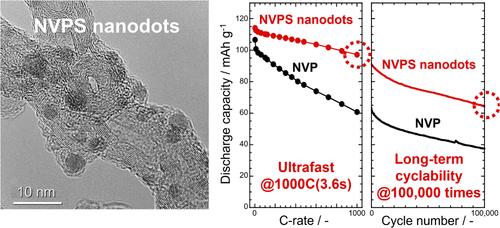Sulfate-Substituted Na3V2(PO4)3 Nanodots Embedded in Carbon Nanotubes for Ultrafast Sodium-Ion Storage
IF 9.1
1区 材料科学
Q1 CHEMISTRY, MULTIDISCIPLINARY
引用次数: 0
Abstract
Polyanion-substituted sodium vanadium phosphate (Na3V2(PO4)3, NVP) derivatives, including SO4, BO3, WO4, and SiO4 substitutions, were systematically synthesized and impregnated with a nanocarbon network via ultracentrifugation. Among them, nanosized (5–30 nm), highly crystalline, and well-dispersed sulfate-substituted NVP (NVPS) nanodots were directly nucleated onto multiwalled carbon nanotubes, enabling ultrafast electrochemical kinetics. This nanoscale architecture delivered exceptional rate capability, achieving 97 mAh g–1 at 1000C (3.6 s discharge), corresponding to 83% of the theoretical capacity, outperforming conventional NVP. The electrochemical kinetics analysis using a cavity microelectrode revealed reduced polarization, enhanced capacitive charge storage, and rapid sodium ion diffusion during intercalation/deintercalation, facilitated by the conformal interface between NVPS and MWCNT, possibly by sulfate-induced surface modifications. These findings establish polyanion substitution and ultracentrifugation-assisted materials processing as a transformative strategy for overcoming intrinsic transport limitations in NASICON-type phosphates, positioning NVPS as a benchmark material for next-generation high-power sodium-ion batteries and hybrid capacitors.

碳纳米管中嵌入硫酸盐取代Na3V2(PO4)3纳米点的超快钠离子存储
系统合成了聚阴离子取代磷酸钒钠(Na3V2(PO4)3, NVP)衍生物,包括SO4, BO3, WO4和SiO4取代,并通过超离心浸渍纳米碳网络。其中,纳米尺寸(5-30 nm)、高结晶性、分散良好的硫酸盐取代NVP (NVPS)纳米点被直接成核到多壁碳纳米管上,实现了超快的电化学动力学。这种纳米级结构提供了卓越的倍率能力,在1000C (3.6 s放电)下达到97 mAh g-1,相当于理论容量的83%,优于传统的NVP。利用空腔微电极进行的电化学动力学分析表明,NVPS和MWCNT之间的保形界面可能是硫酸盐诱导的表面修饰,在插插/脱插过程中,NVPS和MWCNT之间的保形界面促进了极化降低、电容电荷存储增强和钠离子快速扩散。这些发现确立了聚阴离子取代和超离心辅助材料加工是克服nasicon型磷酸盐固有输运限制的变革策略,将NVPS定位为下一代高功率钠离子电池和混合电容器的基准材料。
本文章由计算机程序翻译,如有差异,请以英文原文为准。
求助全文
约1分钟内获得全文
求助全文
来源期刊

Nano Letters
工程技术-材料科学:综合
CiteScore
16.80
自引率
2.80%
发文量
1182
审稿时长
1.4 months
期刊介绍:
Nano Letters serves as a dynamic platform for promptly disseminating original results in fundamental, applied, and emerging research across all facets of nanoscience and nanotechnology. A pivotal criterion for inclusion within Nano Letters is the convergence of at least two different areas or disciplines, ensuring a rich interdisciplinary scope. The journal is dedicated to fostering exploration in diverse areas, including:
- Experimental and theoretical findings on physical, chemical, and biological phenomena at the nanoscale
- Synthesis, characterization, and processing of organic, inorganic, polymer, and hybrid nanomaterials through physical, chemical, and biological methodologies
- Modeling and simulation of synthetic, assembly, and interaction processes
- Realization of integrated nanostructures and nano-engineered devices exhibiting advanced performance
- Applications of nanoscale materials in living and environmental systems
Nano Letters is committed to advancing and showcasing groundbreaking research that intersects various domains, fostering innovation and collaboration in the ever-evolving field of nanoscience and nanotechnology.
 求助内容:
求助内容: 应助结果提醒方式:
应助结果提醒方式:


